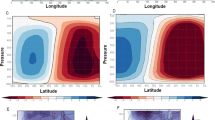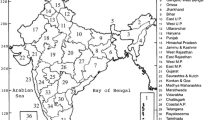Abstract
The 2009 drought in India was one of the major droughts that the country faced in the last 100 years. This study describes the anomalous features of 2009 summer monsoon and examines real-time seasonal predictions made using six general circulation models (GCMs). El Niño conditions evolved in the Pacific Ocean, and sea surface temperatures (SSTs) over the Indian Ocean were warmer than normal during monsoon 2009. The observed circulation patterns indicate a weaker monsoon in that year over India with weaker than normal convection over the Bay of Bengal and Indian landmass. Skill of the GCMs during hindcast period shows that neither these models simulate the observed interannual variability nor their multi-model ensemble (MME) significantly improves the skill of monsoon rainfall predictions. Except for one model used in this study, the real-time predictions with longer lead (2- and 1-month lead) made for the 2009 monsoon season did not provide any indication of a highly anomalous monsoon. However, with less lead time (zero lead), most of the models as well as the MME had provided predictions of below normal rainfall for that monsoon season. This study indicates that the models could not predict the 2009 drought over India due to the use of less warm SST anomalies over the Pacific in the longer lead runs. Hence, it is proposed that the uncertainties in SST predictions (the lower boundary condition) have to be represented in the model predictions of summer monsoon rainfall over India.














Similar content being viewed by others
References
Ashok K, Guan Z, Yamagata T (2001) Impact of the Indian Ocean dipole on the relationship between the Indian Monsoon rainfall and ENSO. Geophys Res Lett 26:4499–4502
Ashok K, Weng H, Behera S, Rao SA, Yamagata T (2007) El Niño Modoki and its teleconnection. J Geophys Res 112:C11007. doi:10.1029/2006JC003798
Dash SK, Singh GP, Shekar MS, Vernekar AD (2005) Response of the Indian summer monsoon circulation and rainfall to seasonal snow depth anomaly over Eurasia. Clim Dyn 24:1–10
Francis PA, Gadgil (2009) The aberrant behaviour of the Indian monsoon in June 2009. Curr Sci 97:1291–1295
Gadgil S, Vinayachandran PN, Francis PA (2003) Droughts of the Indian summer monsoon: role of clouds over the Indian Ocean. Curr Sci 85(12):1713–1719
Gadgil S, Rajeevan M, Nanjundiah R (2005) Monsoon prediction—why yet another failure? Curr Sci 88:1389–1400
Goswami P, Srividya (1996) A novel neural network design for long-range prediction of rainfall pattern. Curr Sci 70:447–457
Goswami BN (1998) Interannual variation of Indian summer monsoon in a GCM: external conditions versus internal feedbacks. J Climate 11:501–522
Gowariker V, Thapliyal V, Kulshrestha SM, Mandal GS, Sen Roy N, Sikka DR (1991) A power regression model for long-range forecast of southwest monsoon rainfall over India. Mausam 42:125–130
Hagedorn R, Doblas-Reyes FJ, Palmer TN (2005) The rationale behind the .... climate prediction using DEMETER forecast. Tellus 57A:280–289
Joseph S, Sahai AK, Goswami BN (2008) Eastward propagating MJO during boreal summer and Indian monsoon droughts. Clim Dyn 32:1139–1153. doi:10.1007/s00382-008-0412-8
Joseph S, Sahai AK, Goswami BN (2009) Boreal summer intraseasonal oscillations and seasonal Indian monsoon prediction in DEMETER coupled models. Clim Dyn 35:651–667. doi:10.1007/s00382-009-0635-3
Kanamitsu M, Ebisuzaki W, Woollen J, Yang SK, Hnilo JJ, Fiorino M, Potter GL (2002) NCEP-DOE AMIP-II reanalysis (R-2). Bull Amer Meteor Soc 83:1631–1643
Kar SC, Masato S, Nobuo S (2001) Interannual variability of the Indian summer monsoon and internal variability in the JMA global model simulations. J Meteor Soc Japan 79(2):607–623
Kar SC, Hovsepyan A, Park CK (2006) Economic values of the APCN multi-model ensemble categorical seasonal predictions. Meteorol Appl 13(3):267–277
Kar SC (2007) Global model simulations of interannual variability of the Indian summer monsoon using observed SST variability. NCMRWF research report, NMRF/RR/3/2007, 44pp
Kar SC, N Acharya, UC Mohanty, MA Kulkarni (2011) Skill of mean of distribution of monthly rainfall over India during July using multi-model ensemble schemes. Int J Climatol (under review)
Krishnan R, Kumar V, Sugi M, Yoshimura J (2009) Internal feedbacks from monsoon-midlatitude interactions during droughts in the Indian summer monsoon. J Atmos Scie 66(3):553–578
Luo J-J, Masson S, Roeckner E, Madec G, Yamagata T (2005) Reducing climatology bias in an ocean-atmosphere CGCM with improved coupling physics. J Climate 18:2344–2360
Navone HD, Ceccatto HA (1994) Predicting Indian monsoon rainfall: a neural network approach. Clim Dyn 10:305–312
Pacanowski RC, Griffes SM (1998) MOM 3.0 manual. NOAA/Geophysical Fluid Dynamics Laboratory, Princeton, 608 pp
Pattanaik DR, Kumar A (2010) Prediction of summer monsoon rainfall over India using the NCEP climate forecast system. Clim Dyn 34:557–572
Prasad K, Dash SK, Mohanty UC (2009) A logistic regression approach for monthly rainfall forecasts in meteorological subdivisions of India based on DEMETER retrospective forecasts. Int J Climatol 30:1577–1588
Rajeevan M, Bhate J, Kale J, Lal B (2006) High resolution daily gridded rainfall data for the Indian region: analysis of break and active monsoon spells. Curr Sci 91:296–306
Rajeevan M, Pai DS, Anil Kumar R, Lal B (2007) New statistical models for long-range forecasting of southwest monsoon rainfall over India. Climate Dyn 28:813–828. doi:10.1007/s00382-006-019706
Rasmusson EM, Carpenter TH (1983) The relationship between eastern equatorial Pacific sea surface temperatures and rainfall over India and Sri Lanka. Mon Weather Rev 111:517–528
Reynolds RW, Smith TM (1994) Improved global sea surface temperature analyses. J Climate 7:929–948
Roeckner, E, and Coauthors (1996) The atmospheric general circulation model ECHAM4: model description and simulation of present-day climate. Max-Planck-Institut fur Meteorologie Rep. 218, Hamburg, 90 pp
Ratnam JV, Behera SK, Masumoto Y, Takahashi K, Yamagata T (2010) Pacific Ocean origin for the 2009 Indian summer monsoon failure. Geophys Res Lett 37:L07807. doi:10.1029/2010GL042798
Sahai AK, Soman MK, Satyan V (2000) All India summer monsoon rainfall prediction using artificial neural network. Clim Dyn 16:291–302
Sahai AK, Grimm AM, Satyan V, Pant GB (2003) Long-lead prediction of Indian summer monsoon rainfall from global SST evolution. Clim Dyn 20:855–863
Saji NH, Goswami BN, Vinayachandran PN (1999) A dipole mode in the tropical Indian Ocean. Nature 401(23):360–363
Shukla J (1987) Interannual variability of monsoon. In: Fein JS, Stephens PL (eds) Monsoons. Wiley, New York, pp 399–464
Shukla J, Mooley DA (1987) Empirical prediction of the summer monsoon rainfall over India. Mon Weather Rev 115:695–703
Sikka DR (1980) Some aspects of the large scale fluctuations of summer monsoon rainfall over India in relation to fluctuations in the planetary and regional scale circulations parameters. Proc Ind Acad Sci (Earth Planet Scie) 89:179–195
Thapliyal V (1981) ARIMA model for long-range prediction of monsoon rainfall in Peninsular India. India Meteorological Department Monograph Climatology no. 12/81
Webster PJ, Palmer T, Yanai M, Tomas R, Magana V, Shukla J, Yasunari A (1998) Monsoons: processes, predictability and the prospects for prediction. J Geophys Res 103:14,451–14,510
Acknowledgments
This research has been conducted as part of the project entitled “Development and Application of Extended Range Forecast System for Climate Risk Management in Agriculture” at IIT, Delhi sponsored by the Department of Agriculture and Cooperation, Government of India. India Meteorological Department (IMD) is acknowledged for providing observed gridded rainfall datasets. The model datasets used in this study have been provided by the International Research Institute of Climate and Society (IRI), USA. The computing for the GCM simulations made by IRI was partially provided by a grant from the NCAR Climate System Laboratory (CSL) program to the IRI. Authors are highly thankful to Dr. A. Robertson, IRI, USA for numerous inputs, useful suggestions and feedback in course of development of the paper. Japan Agency for Marine-Earth Science and Technology (JAMSTEC), in particular, Jing-Jia Luo and Toshio Yamagata are duly acknowledged for providing their model's products used in this study.
Author information
Authors and Affiliations
Corresponding author
Rights and permissions
About this article
Cite this article
Acharya, N., Kar, S.C., Mohanty, U.C. et al. Performance of GCMs for seasonal prediction over India—a case study for 2009 monsoon. Theor Appl Climatol 105, 505–520 (2011). https://doi.org/10.1007/s00704-010-0396-2
Received:
Accepted:
Published:
Issue Date:
DOI: https://doi.org/10.1007/s00704-010-0396-2




